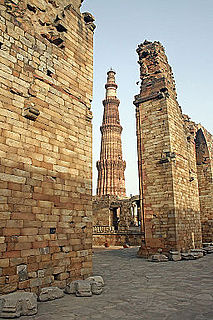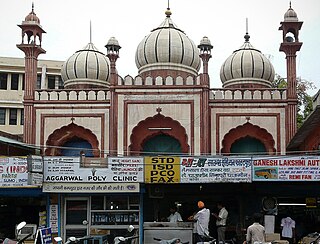Related Research Articles

The Qutb complex are monuments and buildings from the Delhi Sultanate at Mehrauli in Delhi in India. Construction of the Qutub Minar "victory tower" in the complex, named after the religious figure Sufi Saint Khwaja Qutbuddin Bakhtiar Kaki, was begun by Qutb-ud-din Aibak, who later became the first Sultan of Delhi of the Mamluk dynasty. It was continued by his successor Iltutmish, and finally completed much later by Firoz Shah Tughlaq, a Sultan of Delhi from the Tughlaq dynasty (1320-1412) in 1368 AD. The Qubbat-ul-Islam Mosque, later corrupted into Quwwat-ul Islam, stands next to the Qutb Minar.

The Walled City of Lahore, also known as Old City, forms the historic core of Lahore, Pakistan. The city was established around 1000 CE in the western half of the Walled City, which was fortified by a mud wall during the medieval era.

Humayun's tomb is the tomb of the Mughal Emperor Humayun in Delhi, India. The tomb was commissioned by Humayun's first wife and chief consort, Empress Bega Begum, in 1558, and designed by Mirak Mirza Ghiyas and his son, Sayyid Muhammad, Persian architects chosen by her. It was the first garden-tomb on the Indian subcontinent, and is located in Nizamuddin East, Delhi, India, close to the Dina-panah Citadel, also known as Purana Qila, that Humayun found in 1533. It was also the first structure to use red sandstone at such a scale. The tomb was declared a UNESCO World Heritage Site in 1993, and since then has undergone extensive restoration work, which is complete. Besides the main tomb enclosure of Humayun, several smaller monuments dot the pathway leading up to it, from the main entrance in the West, including one that even pre-dates the main tomb itself, by twenty years; it is the tomb complex of Isa Khan Niyazi, an Afghan noble in Sher Shah Suri's court of the Suri dynasty, who fought against the Mughals, constructed in 1547 CE.

The Masjid-i Jehan-Numa, commonly known as the Jama Masjid of Delhi, is one of the largest mosques in India.

Mughal architecture is the type of Indo-Islamic architecture developed by the Mughals in the 16th, 17th and 18th centuries throughout the ever-changing extent of their empire in the Indian subcontinent. It developed the styles of earlier Muslim dynasties in India as an amalgam of Islamic, Persian, Turkic and Indian architecture. Mughal buildings have a uniform pattern of structure and character, including large bulbous domes, slender minarets at the corners, massive halls, large vaulted gateways, and delicate ornamentation; Examples of the style can be found in modern-day India, Afghanistan, Bangladesh, and Pakistan.

Major-general Sir David Ochterlony, 1st Baronet of Pitforthy, 1st Baronet of OchterlonyGCB was a Massachusetts born military officer of the East India Company in British India. He held the powerful post of British Resident to the Mughal court at Delhi.

Indo-Islamic architecture is the architecture of the Indian subcontinent produced by and for Islamic patrons and purposes. Despite an initial Arab presence in Sindh, the development of Indo-Islamic architecture began in earnest with the establishment of Delhi as the capital of the Ghurid dynasty in 1193. Succeeding the Ghurids was the Delhi Sultanate, a series of Central Asian dynasties that consolidated much of North India, and later the Mughal Empire by the 15th century. Both of these dynasties introduced Persianate architecture and art styles from Western Eurasia into the Indian subcontinent.

Lal Masjid of Delhi, also known as the Fakr-ul Masjid or Sikandar Sahib's Masjid, is a mosque located in Bara Bazaar, Kashmiri Gate in Old Delhi, India.
Pakistani architecture is intertwined with the architecture of the broader Indian subcontinent. With the beginning of the Indus civilization around the middle of the 3rd millennium BC, for the first time in the area which encompasses today's Pakistan an advanced urban culture developed with large structural facilities, some of which survive to this day. This was followed by the Gandhara style of Buddhist architecture that borrowed elements from Ancient Greece. These remnants are visible in the Gandhara capital of Taxila.

Begum Shahi Mosque, officially The Mosque ofMariyam Zamani Begum, is an early 17th-century mosque situated in the Walled City of Lahore, Punjab, Pakistan. The mosque was built between 1611 and 1614 during the reign of Mughal Emperor Jahangir in honour of his mother. It is Lahore's earliest surviving example of a Mughal-era mosque, and influenced construction of the larger Wazir Khan Mosque a few decades later. This mosque was turned in name of most celebrated Sikh hero Bhai Mani Singh ji, as Shaheed Ganj Bhai Mani Singh, under Sikh rule.

The Jama Masjid is a 17th-century congregational mosque located in the historic core of Agra, Uttar Pradesh. It was built by Jahanara Begum, Padshah Begum of the Mughal Empire, during the reign of her father, Mughal Emperor Shah Jahan. It is one of the largest mosques in India. Today it is still in use, serving as the principal mosque for the city of Agra. It stands opposite to the Agra Fort, and overlooks the Agra Fort Railway Station.

The Fatehpuri Mosque is a 17th-century mosque located at the western end of the oldest street of Delhi, Chandni Chowk, North Delhi, Delhi, India. It is opposite the Red Fort on the opposite end of Chandni Chowk.

Moth Ki Masjid is a heritage building located in Delhi, and was built in 1505 by Wazir Miya Bhoiya, Prime Minister during the reign of Sikander Lodi (1489–1517) of the Lodi dynasty. It was a new type of mosque developed by the Lodis in the fourth city of the medieval Delhi of the Delhi Sultanate. The name of the mosque literally translated into English language means ‘Lentil Mosque’ and this name tag ‘Lentil’ has an interesting legend. This mosque was considered a beautiful Dome (Gumbad) structure of the period.

Balapur Fort is a Mughal fortress in the town of Balapur in the Akola district of India. Construction on the fort was started by Mirza Azam Shah, the son of Emperor Aurangzeb and it was completed by Ismaeel Khan, the Nawab of Elichpur in 1757. The chhatri of Raja Man Singh I, a canopy constructed by Mirza Raja Jaisingh, has an area of 25 square feet and a height of 33 feet. Its foundations were heavily damaged in a great flood called the 'dhvdya pur' which occurred more than 100 years ago, but after some years the damage was repaired at a cost of Rs 3,000 received from Jaipur.

Akbarabadi Mosque was a mosque in Delhi, India. It was built by Akbarabadi Mahal, one of Shah Jahan's wives in 1650. One of the several Mughal era mosques in Old Delhi, it was demolished by the British, following their recapture of Delhi during the 1857 Uprising. It is believed to have existed in modern-day Netaji Subhash Park locality of Old Delhi.

The Golden Mosque is a mosque in Old Delhi. It is located outside the southwestern corner of Delhi Gate of the Red Fort, opposite the Netaji Subhash Park.

The Sunehri Masjid is an 18th-century mosque in Old Delhi. It was built by Mughal noble Roshan-ud-Daula, during the reign of Mughal Emperor Muhammad Shah. It is located near the Gurudwara Sis Ganj Sahib in Chandni Chowk, once an imperial boulevard leading to the Red Fort.

Persian Inscriptions on Indian Monuments is a book written in Persian by Dr Ali Asghar Hekmat E Shirazi and published in 1956 and 1958 and 2013. New edition contains the Persian texts of more than 200 epigraphical inscriptions found on historical monuments in India, many of which are currently listed as national heritage sites or registered as UNESCO world heritage, published in Persian; an English edition is also being printed.

The Kabuli Bagh Mosque is a mosque in Panipat which was built in 1527 by the emperor Babur to mark his victory over Sultan Ibrahim Lodhi at the first Battle of Panipat in 1526. The mosque located in Panipat is named after Kabuli Begum, Babur's wife.

The tomb of the noble Isa Khan Niazi is located in the Humayun's Tomb complex in Delhi, India. The mausoleum, octagonal in shape and built mainly of red sandstone, was built in 1547–1548 during the reign of Sher Shah Suri. The mosque of Isa Khan is located west of the mausoleum, which along with other buildings form the UNESCO World Heritage Site of Humayun's tomb complex.
References
- ↑ "Heavy rains damage 200-year-old mosque in Indian capital". www.aljazeera.com. Retrieved 20 July 2020.
- ↑ Shekhar, Himanshu (20 July 2020). "Central dome of iconic Masjid Mubarak mosque in Old Delhi collapses in rain". www.indiatvnews.com. Retrieved 20 July 2020.
- ↑ "Delhi rains: Downpour damages central dome of 200-year-old Masjid Mubarak Begum". The New Indian Express. Retrieved 20 July 2020.
- ↑ "Central dome of heritage mosque 'Masjid Mubarak Begum' in Old Delhi damaged in heavy rain". cnbctv18.com. Retrieved 20 July 2020.
- ↑ "Twitter Remembers Mughal Courtesan Mubarak Begum as Delhi Rain Damages 19th Century Mosque". News18. Retrieved 20 July 2020.
- ↑ "Masjid Mubarak Begum: The story behind 'Rundi ki masjid', built by an ambitious Mughal concubine". The Indian Express. 20 July 2020. Retrieved 20 July 2020.
- ↑ SALAM, ZIYA US. "Dome of two-centuries-old Mubarak Begum Masjid collapses in Delhi rain". Frontline. Retrieved 20 July 2020.
- ↑ "Mubarak Begum Ki Masjid: Heavy rains damage a rare mosque built by a woman". National Herald. Retrieved 20 July 2020.

